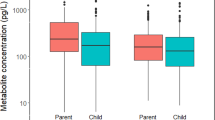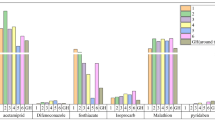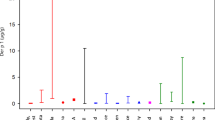Abstract
This study characterized exposures of eight children living in an agricultural community near potato fields that were treated by aerial application with the organophosphorus (OP) insecticide, methamidophos (O,S-dimethyl phosphoramidothioate). Exposure monitoring included air and deposition samples in the outdoor community environment, outdoor and indoor air samples at each residence, wipe samples of playground equipment, toys, indoor surfaces, and children's hands, and periodic urine samples. Monitoring occurred prior to, the day of, and 1 day following applications. Methamidophos deposition in the community was very low compared to deposition inside the boundaries of the treated fields. Community air concentrations increased from 0.05 μg/m3 (prespray) to 0.11 and 0.48 μg/m3 (spray day morning and afternoon, respectively), decreasing to 0.10 μg/m3 on the postspray day. Air concentrations outside residences followed a similar pattern; indoor levels did not exceed 0.03 pg/m3. Methamidophos residues were found on playground equipment following applications, but not on indoor residential surfaces. The median hand wipe levels increased from <0.02 (prespray) to 0.08 μg/sample (spray day), decreasing to 0.05 μg/sample (postspray day). Median concentrations of the primary methamidophos urinary metabolite were 61 μg/l before 1100 hours on the spray day, 170 μg/l after 1100 hours on the spray day, and 114 μg/l on the postspray day. Spray day metabolite levels were correlated with time outside on the spray day (rs=0.68), with spray day hand wipe levels (rs=0.67), and with postspray day metabolite levels (rs=0.64). Postspray day metabolites levels were also positively associated with postspray day hand wipe levels (rs=0.66). The documentation of children's exposure in this study does not necessarily mean that risks for these children were significantly altered, since nearly all children in the United States are exposed to some level of OP pesticides through dietary intake and other pathways. The association of metabolite levels with time spent outside, and the absence of methamidophos in homes indicates that children's exposures occurred primarily outdoors.
This is a preview of subscription content, access via your institution
Access options
Subscribe to this journal
Receive 6 print issues and online access
$259.00 per year
only $43.17 per issue
Buy this article
- Purchase on Springer Link
- Instant access to full article PDF
Prices may be subject to local taxes which are calculated during checkout



Similar content being viewed by others
References
Ames R.G., Howd R.A., and Doherty L. Community exposure to paraquat drift. Arch Environ Health 1993: 48: 47–52.
Barnes C.J., Lavy T.L., and Mattice J.D. Exposure to non-applicator personnel and adjacent areas to aerially applied propanil. Bull Environ Contam Toxicol 1987: 39: 126–133.
Clark J.M., Marion J.R., Tessier D.M., Brooks M.W., and Coli W.M. Airborne drift residues collected near apple orchard environments due to application of insecticide mixtures. Bull Environ Contam Toxicol 1991: 46: 829–836.
Draper W.M., Gibson R.D., and Street J.C. Drift from and transport subsequent to a commercial, aerial application of carbofuran: an estimation of potential human exposure. Bull Environ Contam Toxicol 1981: 26: 537–543.
Elgethun K., Fenske R.A., Yost M.G., and Palcisko G.J. Time–location analysis for exposure assessment studies of children using a novel global positioning system instrument. Environ Health Perspect 2003: 111: 115–122.
Garcia A.M., Sabater M.C., Mendoza M.T., Ballester F., and Carrasco J.M. Exposure to organophosphate pesticides in a general population in a rice growing area: an exploratory study. Bull Environ Contam Toxicol 2000: 65: 764–771.
Gilbert A.J., and Bell G.J. Evaluation of drift hazards arising from pesticide spray application. Aspects Appl Biol 1988: 15: 363–376.
Goldman L.R., Mengle D., Epstein D.M., Fredson D., Kelly K., and Jackson R.J. Acute symptoms in persons residing near a field treated with the soil fumigants methyl bromide and chloropicrin. West J Med 1987: 147 (1): 95–98.
Loewenherz C., Fenske R.A., Simcox N.J., Bellamy G., and Kalman D. Biological monitoring of organophosphorus pesticide exposure among children of agricultural workers. Environ Health Perspect 1997: 105: 1344–1353.
Lu C., Fenske R.A., Simcox N.J., and Kalman D. Pesticide exposure of children in an agricultural community: evidence of household proximity to farmland and take home exposure pathways. Environ Res 2000: 84: 290–302.
Ramaprasad J., Tsai M.Y., Elgethun K., Herbert V.R., Felsot A., Yost M.G., and Fenske R.A. The Washington aerial spray drift study: assessment of off-target organophosphorus insecticide atmospheric movement by plant surface volatilization. Atmos Environ 2004: 38: 5703–5713.
Richards S.M., McClure G.Y.H., Lavy T.L., Mattice J.D., Keller R.J., and Gandy J. Propanil (3,4-dichloropropionanilide) particulate concentrations within and near the residences of families living adjacent to aerially sprayed rice fields. Arch Environ Contam Toxicol 2001: 41: 112–116.
Richter E.D., Chuwers P., Levy Y., Gordon M., Grauer F., Marzouk J., Levy S., Barron S., and Gruener N. Health effects from exposure to organophosphate pesticides in workers and residents in Israel. Israel J Med Sci 1992: 28: 584–598.
Richter E.D., Rosenvald Z., Kaspi L., Levy S., and Gruener N. Sequential cholinesterase tests and symptoms for monitoring organophosphate absorption in field workers and in persons exposed to pesticide spray drift. Toxicol Lett 1986: 33: 25–35.
Riley C.M., Wiesner C.J., and Ernst W.R. Off-target deposition and drift of aerially applied agricultural sprays. Pesticide Sci 1989: 26: 159–166.
Royster M.O., Hilborn E.D., Barr D., Carty C.L., Rhoney S., and Walsh D. A pilot study of global positioning system/geographical information system measurement of residential proximity to agricultural fields and urinary organophosphate metabolite concentrations in toddlers. J Expo Anal Environ Epidemiol 2002: 12: 433–440.
Salyani M., and Cromwell R.P. Spray drift from ground and aerial applications. Trans ASAE 1992: 35: 1113–1120.
Simcox N., Fenske R., Wolz S., Lee I., and Kalman D. Pesticides in household dust and soil: exposure pathways for children of agricultural families. Environ Health Perspect 1995: 103: 1126–1134.
Tomaszewska E., and Hebert V.R. Analysis of O,S-dimethyl hydrogen phosphorothioate in urine, a specific biomarker for methamidophos. J Agric Food Chem 2003: 51: 6103–6109.
Tsai M.Y., Elgethun K., Ramaprasad J., Yost M.G., Felsot A., Herbert V.R., and Fenske R.A. The Washington aerial spray drift study: modeling pesticide spray drift deposition from an aerial application. Atmos Environ 2005: 39: 6194–6203.
Woodrow J.E., Seiber J.N., and Baker L.W. Correlation techniques for estimating pesticide volatilization flux and downwind concentrations. Environ Sci Technol 1997: 31: 523–529.
Woods N., Craig I.P., Dorr G., and Young B. Spray drift of pesticides arising from aerial application in cotton. J Environ Qual 2001: 30: 697–701.
Acknowledgements
This work was supported by US Environmental Protection Agency (R826886) and the National Institute of Environmental Health Sciences (PO1ES09601) Child Health Centers Program, and the Agricultural Centers Program of the National Institute for Occupational Safety and Health (No. 5 U50 OH07544). We thank Jianbo Yu for biological sample analysis, and the study families for their participation.
Author information
Authors and Affiliations
Corresponding author
Rights and permissions
About this article
Cite this article
Weppner, S., Elgethun, K., Lu, C. et al. The Washington aerial spray drift study: Children's exposure to methamidophos in an agricultural community following fixed-wing aircraft applications. J Expo Sci Environ Epidemiol 16, 387–396 (2006). https://doi.org/10.1038/sj.jea.7500461
Received:
Accepted:
Published:
Issue Date:
DOI: https://doi.org/10.1038/sj.jea.7500461
Keywords
This article is cited by
-
Pesticide contamination and associated risk factors at public playgrounds near intensively managed apple and wine orchards
Environmental Sciences Europe (2019)
-
Evaluation of the relationship between residential orchard density and dimethyl organophosphate pesticide residues in house dust
Journal of Exposure Science & Environmental Epidemiology (2019)
-
Acetylcholinesterase activity and time after a peak pesticide-use period among Ecuadorian children
International Archives of Occupational and Environmental Health (2018)
-
Pesticide exposure assessed through agricultural crop proximity and risk of amyotrophic lateral sclerosis
Environmental Health (2017)
-
Aerial pesticide application causes DNA damage in pilots from Sinaloa, Mexico
Environmental Science and Pollution Research (2017)



